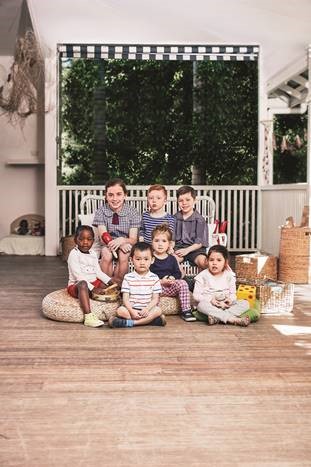WHY IS THE GOVERNMENT MAKING THESE CHANGES?
The Government recognises that current child care fee assistance arrangements are complex, difficult for families to use and need to change to support the modern Australian family. That’s why it has committed $2.5 billion in extra funding to help families meet work requirements and to provide more targeted support for disadvantaged and vulnerable families.
How is child care fee assistance changing?
From 2 July 2018, the Child Care Rebate and Child Care Benefit will be replaced by a single Child Care Subsidy.
Families earning around $65,000 (in 2017 terms) or less will be eligible for a subsidy of 85 per cent of the actual fee charged, or of the relevant hourly rate cap (whichever is lower). As family income increases, the rate of subsidy will decrease, reaching zero per cent for families with incomes of $350,000^ or more.
Families earning less than $185,710^ will also have no annual cap on the amount of Child Care Subsidy they can receive. Families earning over $185,710^ and under $350,000^ will benefit from an increase in the current annual cap of $7,613 to $10,000^ per child, per year.
A new Child Care Safety Net will also better support vulnerable families and disadvantaged communities.
HOW WILL THE NEW CHILD CARE PACKAGE MAKE CHILD CARE AFFORDABLE?
Under the new arrangements, most lower and middle-income families will be eligible to receive a higher subsidy than they do now. Currently, all families are subject to the Child Care Rebate annual cap of $7,613 per year per child. Under the new child care package, from 2 July 2018 families on incomes of around $185,000 or less will not be subject to an annual cap on the amount of subsidy they are eligible to receive. Families earning more than around $185,000 and under $350,000^ will benefit from an increased annual cap of $10,000^ per year, per child.
When does the Child Care Rebate and Child Care Benefit stop and the new Child Care Subsidy start?
The new Child Care Subsidy will begin on 2 July 2018 and will replace the current Child Care Rebate and Child Care Benefit.
HOW WILL THE NEW SUBSIDY BE PAID?
The new Child Care Subsidy will be paid directly to child care providers. Parents will pay their provider the difference between the subsidy and the fees charged.
How do I know if I am eligible for the new subsidy? What eligibility criteria will families be required to meet under the new subsidy? Are there any criteria families have to meet to be eligible for the Child Care Subsidy?
To be eligible for the Child Care Subsidy, you need to:
use approved child care
be responsible for paying the child care fees for your child
ensure your child is immunised, on an immunisation catch up schedule, or is exempt from the immunisation requirements meet the residency requirements.
Families will also be assessed on their combined family income and will be required to meet an activity test, unless they are earning around $65,000 or less.
Is the Child Care Subsidy entitlement for families capped at 100 hours per fortnight? If so, why?
Yes, the Child Care Subsidy is capped at 100 hours per fortnight per child for families that meet the highest step of the activity test. This is similar to the current Child Care Benefit and Child Care Rebate arrangements.
Data indicates that most children, on average, attend child care for 25 hours/week. Currently around six per cent of children attend care for more than 50 hours per week.
What happens if the rebate percentage is over the capped amount? My child care centre charges $13 per hour, does that mean I receive 85% of the hourly rate cap or 85% of $13?
A family using centre-based care and paying $13 per hour (which is more than the maximum hourly rate cap) will have their subsidy based on the hourly rate cap for that type of service ($11.55^ per hour, per child). If they are entitled to 85% of this, they will receive a subsidy of $9.82 per hour, per child.
WHY IS THERE NO SUBSIDY FOR HIGH INCOME(THOSE EARNING $350,000) FAMILIES?
The Government is committed to helping families who are most in need of financial support. That’s why families with a combined household income of more than $350,000^ will not be eligible for the Child Care Subsidy.
WHAT IS THE FAMILY CHILD CARE SUBSIDY ESTIMMATOR?
The Family Child Care Subsidy Estimator is available for families to help work out how much Government subsidy they may be eligible for. It’s easy to use and only takes a few minutes to fill out. It’s available at education.gov.au/childcare.
HOW DOES THIS ACTIVITY TEST WORK?
The activity test more closely aligns the hours of subsidised child care with how much combined work, study, training or other recognised activity families undertake. The higher the level of recognised activity, the more hours of subsidised care a family can access, up to a maximum of 100 hours of subsidy per fortnight, per child.
HOW MUCH US BEING INVESTED INTO THE CHILD CARE SAFETY NET?
A total of $1.2 billion is being invested into the Child Care Safety Net to help disadvantaged and vulnerable families to ensure their children are able to participate in early learning services.
How will the Child Care Safety Net support vulnerable and/or disadvantaged children (and communities) in particular Aboriginal and Torres Strait Islander children?
The Government is committed to helping the most vulnerable children get a strong start, while supporting families to enter or re-enter the workforce. The Child Care Safety Net specifically supports Indigenous children through a number of programs:
The Community Child Care Fund (CCCF) is designed to help services address barriers to early learning and child care participation, particularly targeting services operating in disadvantaged communities, including Indigenous communities
As part of CCCF, the Connected Beginnings program provides funding for the integration of child care, maternal and child health and family support services in a number of Indigenous communities.
The Additional Child Care Subsidy provides targeted fee assistance to provide practical help to families and grandparents, and helps parents transition from income support to work, as well as helping families experiencing temporary financial hardship.
The Inclusion Support Program, which commenced on 1 July 2016, is designed to assist early learning and child care services to include children with additional needs by providing
tailored inclusion advice and support from contracted inclusion agencies, as well as funding to support more challenging inclusion barriers.










Leave a Reply